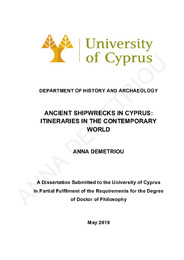Ancient shipwrecks in Cyprus : itineraries in the contemporary world

View/
Date
2019-05Author
Demetriou, Anna A.Publisher
Πανεπιστήμιο Κύπρου, Φιλοσοφική Σχολή / University of Cyprus, Faculty of LettersPlace of publication
ΚύπροςCyprus
Google Scholar check
Keyword(s):
Metadata
Show full item recordAbstract
Η παρουσίαση αρχαίων ναυαγίων στο κοινό υπήρξε στο επίκεντρο της αρχαιολογίας των ναυαγίων ήδη από τα πρώτα βήματα του τομέα το 1960. Οι συζητήσεις επικεντρώθηκαν στα τεχνικά και πρακτικά ζητήματα που προκύπτουν από την παρουσίαση τους. Τα τελευταία χρόνια δόθηκε έμφαση στις διαφορετικές μεθόδους παρουσίασης που στόχο έχουν να ενημερώσουν το κοινό για την αδιαμφισβήτητη αξία των θέσεων και για την ανάγκη προστασίας τους. Ωστόσο, η επιρροή της μεταμοντέρνας σκέψης, ειδικά μέσα από τη μορφή της μετα-διαδικαστικής αρχαιολογίας, έφερε στο προσκήνιο την πολιτική και κοινωνική διάσταση της αρχαιολογικής πρακτικής. Αντίστοιχα, έχει υποστηριχθεί ότι οι μή αρχαιολόγοι συμμετέχουν, σε μια συνεχώς αναδιαμορφούμενη σχέση με τα κατάλοιπα του παρελθόντος, βάσει της οποίας δημιουργούν τη δική τους σχέση με αυτά. Σε αυτό το πλαίσιο έχει υποστηριχθεί ότι η αξία της αρχαιολογίας πηγάζει ταυτόχρονα από τις θέσεις, τους ερευνητές, και το κοινό.Η μελέτη έχει στόχο να καθορίσει τις ιδιαιτερότητες των αρχαίων ναυαγίων ως χώρους αλληλεπίδρασης στη σύγχρονη κοινωνία. Στο επίκεντρο της μελέτης είναι οι τρεις θέσεις που έχουν ανασκαφεί, ή βρίσκονται υπό ανασκαφή στο παρόν στάδιο στην Κύπρο: τα ναυάγια της Κερύνειας, του Μαζωτού και των Νησιών. Η μελέτη εξέτασε το κοινωνικο-πολιτικό πλαίσιο της αρχαιολογικής πρακτικής στην Κύπρο, και τα αφηγήματα που αναπτύχθηκαν γύρω από αυτά, με στόχο να διαπιστώσει την επίσημη τους θέση μέσα στη σύγχρονη κοινωνία. Ταυτόχρονα, πραγματοποιήθηκε εθνογραφική μελέτη γύρω από τα διαφορετικά κοινωνικά σύνολα που αλληλεπιδρούν με τα ναυάγια μετά την ανακάλυψη τους: τις τοπικές κοινότητες, καθώς και τις κοινότητες των ψαράδων και των δυτών που δραστηριοποιούνται στις περιοχές στις οποίες εντοπίστηκαν οι θέσεις. Ξετυλίγοντας τη βιογραφία των ναυαγίων μετά την ανακάλυψή τους, η μελέτη αυτή εντοπίζει τα πολλαπλά νοήματα και αντιλήψεις που αναπτύσσουν γύρω από αυτά οι διάφορες ομάδες μη αρχαιολόγων.
Τα αποτελέσματα της εθνογραφικής έρευνας, συνυφασμένα με την ανάλυση των επιδράσεων της επίσημης αρχαιολογικής πρακτικής στο νησί, παρέχουν μια πολυ-επίπεδη κατανόηση των θέσεων αρχαίων ναυαγίων, πέρα από τις καθιερωμένες αντιλήψεις. Στο πλαίσιο αυτό η μελέτη υποστηρίζει ότι τα αρχαία ναυάγια δεν αποτελούν στατικά αντικείμενα που εμπεριέχουν μια αδιαμφισβήτητη αξία. Οι διαφορετικές σχέσεις που διαμορφώνονται μεταξύ των ναυαγίων και των μη αρχαιολόγων, δημιουργούν συνεχώς αναδιαμορφούμενα νοήματα. Συνεπώς, οι θέσεις αρχαίων ναυαγίων αποτελούν το έναυσμα για τη διαπραγμάτευση διαφορετικών προσωπικών, τοπικών, επαγγελματικών και οικονομικών ταυτοτήτων. Τα πολλαπλά ζητήματα που εξετάζονται στην παρούσα μελέτη οδηγούν προς μια κατεύθυνση: την ανάγκη για μια ενάλια στροφή στην προσέγγιση των διαφορετικών κοινωνικών ομάδων που σχετίζονται με αυτά. Καθώς οι θέσεις αρχαίων ναυαγίων βιώνονται και γίνονται αντιληπτές μέσα από τη θάλασσα, η μελέτη της σχέσης των ανθρώπων με τη θάλασσα μπορεί να φέρει στο προσκήνιο νέες βιωματικές και ερμηνευτικές διαστάσεις των θέσεων μέσα στη σύγχρονη κοινωνία. From the first moments of its appearance in 1960, shipwreck archaeology has been concerned with presenting ancient shipwrecks to the public. Discussions focused on the technical and practical issues of their presentation. In recent years, emphasis has also been given on the need to raise public awareness, awaken appreciation, and communicate the need for their protection. As such, presentation methods aspire to inform the public about the inherent value of the sites and the need for their protection. However, influence of post-modern thought, especially in the form of post-processualism, has brought to the fore the political and social dimensions of archaeological practice. Likewise, it has been supported that non-professionals participate in a constantly renegotiated relationship with the material remains of their past, based on which they create their own associations. In this course, the inherent value of archaeology has been disputed; it is now believed that its value derives simultaneously from the sites, the researchers, and the public. Following this line of thought, the study seeks to define the particularities of ancient shipwrecks as places of interaction and engagements in contemporary society. At the core of this work are the three sites that have been or are being excavated: the Keryneia, the Mazotos, and the Nissia shipwrecks. The study examined the socio-political context of archaeological practice in Cyprus and the narratives produced around ancient shipwrecks, as a means to identify their official position within contemporary society. At the same time, an ethnographic survey was undertaken around the distinct social groups interacting with the shipwrecks following their discovery: local communities, as well as fishing and diving communities active in the area of their location. Through un-folding the biography of the shipwrecks following their discovery, this thesis identifies the multiple meanings and negotiations developed around them by non-professional communities.
The results of the ethnographic survey undertaken, interwoven with an analysis of the impact of official archaeological practice on the island, provide a multi-layered understanding of ancient shipwrecks, which goes beyond the established professionalised conceptions. I contend that rather than being static objects with an inherent value, ancient shipwrecks gather around them multiple and constantly changeable meanings and negotiations based on the distinct relationships developed around them by the non-professional communities. As such, ancient shipwrecks set the ground for negotiating distinct personal, local, professional, and economic identities. The multiplicity of subjects examined in this thesis ultimately point to one direction: the need for a maritime turn in the approach of the distinct community groups associated with ancient shipwrecks. As the sea is the medium through which ancient shipwrecks are perceived, a shift to the current human-sea relationship opens up new experiential and interpretative dimensions of the sites within contemporary society.
